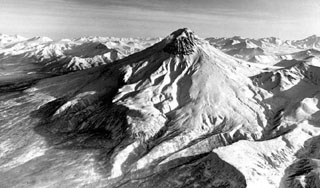Report on Kizimen (Russia) — 26 January-1 February 2011
Smithsonian Institution / US Geological Survey
Weekly Volcanic Activity Report, 26 January-1 February 2011
Managing Editor: Sally Sennert.
Please cite this report as:
Global Volcanism Program, 2011. Report on Kizimen (Russia) (Sennert, S, ed.). Weekly Volcanic Activity Report, 26 January-1 February 2011. Smithsonian Institution and US Geological Survey.
Kizimen
Russia
55.131°N, 160.32°E; summit elev. 2334 m
All times are local (unless otherwise noted)
KVERT reported that during 21-28 January seismicity from Kizimen was high but variable, and many shallow volcanic earthquakes as well as volcanic tremor continued to be detected. Seismic data analyses suggested that ash plumes possibly rose to an altitude greater than 10 km (32,800 ft) a.s.l. on 23 and 25 January, and not more than 6 km (19,700 ft) a.s.l. on the other days. Satellite images showed a bright thermal anomaly over the volcano daily, and ash plumes that drifted more than 325 km W, S, and E. The Aviation Color Code remained at Orange.
Based on analyses of satellite imagery, the Tokyo VAAC reported that a possible eruption on 29 January produced a plume that rose to an altitude of 3.7 km (12,000 ft) a.s.l. and drifted SW. Subsequent images that day and during 30 January-1 February showed continuing ash emissions.
Geological Summary. Kizimen is an isolated, conical stratovolcano that is morphologically similar to St. Helens prior to its 1980 eruption. The summit consists of overlapping lava domes, and blocky lava flows descend the flanks of the volcano, which is the westernmost of a volcanic chain north of Kronotsky volcano. The 2334-m-high edifice was formed during four eruptive cycles beginning about 12,000 years ago and lasting 2000-3500 years. The largest eruptions took place about 10,000 and 8300-8400 years ago, and three periods of long-term lava dome growth have occurred. The latest eruptive cycle began about 3000 years ago with a large explosion and was followed by intermittent lava dome growth lasting about 1000 years. An explosive eruption about 1100 years ago produced a lateral blast and created a 1.0 x 0.7 km wide crater breached to the NE, inside which a small lava dome (the fourth at Kizimen) has grown. Prior to 2010, only a single explosive eruption, during 1927-28, had been recorded in historical time.
Sources: Kamchatkan Volcanic Eruption Response Team (KVERT), Tokyo Volcanic Ash Advisory Center (VAAC)

